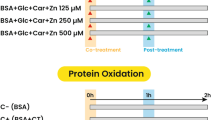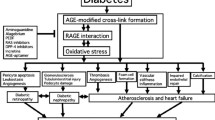Abstract
Increased burden of advanced glycation end-products (AGEs) in case of hyperglycemic conditions leads to the development of retinopathy, nephropathy, and cardiovascular and neurological disorders such as Alzheimer’s disease. AGEs are considered as pro-oxidants, and their accumulation increases the oxidative stress. The prolonged exposure to these AGEs is the fundamental cause of chronic oxidative stress. Abnormal morphology of red blood cells (RBCs) and excessive eryptosis has been observed in diabetes, glomerulonephritis, dyslipidemia, and obesity, but yet the contribution of extracellular AGEs remains undefined. In this study, we investigated the effect of AGEs on erythrocytes to determine their impact on the occurrence of different pathological forms of these blood cells. Specifically, carboxymethyllysine (CML), carboxyethyllysine (CEL), and Arg-pyrimidine (Arg-P) which have been reported to be the most pre-dominant AGEs formed under in vivo conditions were used in this study. Results suggested the eryptotic properties of CML, CEL, and Arg-P for RBCs, which were evident from the highly damaged cell membrane and occurrence of abnormal morphologies. Methylglyoxal-modified albumin showed more severe effects, which can be attributed to the high reactivity and pro-oxidant nature of glycation end products. These findings suggest the possible role of AGE-modified albumin towards the morphological changes in erythrocyte’s membrane associated with diabetic conditions.






Similar content being viewed by others
Abbreviations
- AGEs:
-
Advanced glycation end products
- RBCs:
-
Red blood cells
- HSA:
-
Human serum albumin
- CML:
-
Carboxymethyllysine
- CEL:
-
Carboxyethyllysine
- Arg-P:
-
Arg-pyrimidine
- TNBSA:
-
2,4,6-Trinitrobenzenesulfonic acid
- PNQ:
-
9,10-phenanthrenequinone
- GA:
-
Glyoxylic acid
- PA:
-
Pyruvic acid
- MG:
-
Methylglyoxal
- FE-SEM:
-
Field emission-scanning electron microscopy
References
Vlassara, H., & Uribarri, J. (2014). Advanced glycation end products (AGE) and diabetes: cause, effect, or both? Curr Diabetes Rep, 14, 453.
Bodiga, V. L., Eda, S. R., & Bodiga, S. (2014). Advanced glycation end products: role in pathology of diabetic cardiomyopathy. Heart Failure Reviews, 19, 49–63.
Bucala, R. (2014). Diabetes, aging, and their tissue complications. The Journal of Clinical Investigation, 124, 1887–1888.
Vlassara, H., & Striker, G. E. (2013). Advanced glycation endproducts in diabetes and diabetic complications. Endocrinology and Metabolism Clinics of North America, 42, 697–719.
Willett, T. L., Kandel, R., De Cross, J. N., Avery, N. C., & Grynpas, M. D. (2012). Enhanced levels of non-enzymatic glycation and pentosidine cross-linking in spontaneous osteoarthritis progression. Osteoarthritis and Cartilage, 20, 736–744.
Aronson, D. (2003). Cross-linking of glycated collagen in the pathogenesis of arterial and myocardial stiffening of aging and diabetes. Journal of Hypertension, 21(1), 3–12.
Frye, E. B., Degenhardt, T. P., Thorpe, S. R., & Baynes, J. W. (1998). Role of the Maillard reaction in aging of tissue proteins. Advanced glycation end product-dependent increase in imidazolium cross-links in human lens proteins. The Journal of Biological Chemistry, 273(30), 18714–18719.
Hohn, A., Jung, T., & Grune, T. (2014). Pathophysiological importance of aggregated damaged proteins. Free Radical Biology & Medicine, 71, 70–89.
Guerreo, E., Vasudevaraju, P., Hegde, M. L., Britton, G. B., & Rao, K. S. (2013). Recent advances in α-synuclein functions, advanced glycation, and toxicity: implications for Parkinson's disease. Molecular Neurobiology, 47(2), 525–536.
Moreau, K. L., & King, J. A. (2012). Protein misfolding and aggregation in cataract disease and prospects for prevention. Trends in Molecular Medicine, 18(5), 273–282.
Nowotny, K., Jung, T., & Hohn, A. (2014). Accumulation of modified proteins and aggregate formation in aging. Experimental Gerontology, 57, 122–131.
Ikeda, K., Higashi, T., Sano, H., Jinnouchi, Y., Yoshida, M., Araki, T., & Horiuchi, S. (1996). N (epsilon)-(carboxymethyl)lysine protein adduct is a major immunological epitope in proteins modified with advanced glycation end products of the Maillard reaction. Biochemistry, 35, 8075–8083.
Reddy, S., Bichler, J., Wells-Knecht, K. J., Thorpe, S. R., & Baynes, J. W. (1995). N epsilon-(carboxymethyl)lysine is a dominant advanced glycation end product (AGE) antigen in tissue proteins. Biochemistry, 34, 10872–10878.
Rabbani, N., & Thornalley, P. J. (2014). The critical role of methylglyoxal and glyoxalase 1 in diabetic nephropathy. Diabetes, 63, 50–52.
Turkseven, S., Ertuna, E., Yetik-Anacak, G., & Yasa, M. (2013). Methylglyoxal causes endothelial dysfunction: the role of endothelial nitric oxide synthase and AMP-activated protein kinase alpha. Journal of Basic and Clinical Physiology and Pharmacology, 14, 1–7.
Vlassopoulos, A., Lean, M. E., & Combet, E. (2013). Role of oxidative stress in physiological albumin glycation: a neglected interaction. Free Radical Biology & Medicine, 60, 318–324.
Reddy, V. P., Zhu, X., Perry, G., & Smith, M. A. (2009). Oxidative stress in diabetes and Alzheimer’s disease. Journal of Alzheimer’s disease, 16(4), 763–774.
Li, H., Horke, S., & Forstermann, U. (2013). Oxidative stress in vascular disease and its pharmacological prevention. Trends in Pharmacological Sciences, 34(6), 313–319.
Schaffer, S. W., Jong, C. J., & Mozaffari, M. (2012). Role of oxidative stress in diabetes-mediated vascular dysfunction: unifying hypothesis of diabetes revisited. Vascular Pharmacology, 57(5–6), 139–149.
Huebschmann, A. G., Regensteiner, J. G., Vlassara, H., & Reusch, J. E. (2006). Diabetes and advanced glycoxidation end products. Diabetes Care, 29(6), 1420–1432.
Cohen, M. P., & Ziyadeh, F. N. (1996). Role of Amadori-modified nonenzymatically glycated serum proteins in the pathogenesis of diabetic nephropathy. Journal of the American Society of Nephrology, 7, 183–190.
Kim, M. R., Yu, S. A., Kim, M. Y., Choi, K., & Kim, C. W. (2014). Analysis of glycated serum proteins in type 2 diabetes patients with nephropathy. Biotechnolo Bioprocs Eng, 19, 83–92.
Stirban, A., Gawlowski, T., & Roden, M. (2014). Vascular effects of advanced glycation endproducts: clinical effects and molecular mechanisms. Mol Metab, 3, 94–108.
Kamruzzahan, A. S., Kienberger, F., Stroh, C. M., Berg, J., Huss, R., Ebner, A., & Hinterdorfer, P. (2004). Imaging morphological details and pathological differences of red blood cells using tapping-mode AFM. Biological Chemistry, 385, 955–960.
Umudum, F., Yucel, O., Sahin, Y., & Bakan, E. (2002). Erythrocyte membrane glycation and NA(+)-K(+) levels in NIDDM. J Diabetes Complication, 16, 359–362.
Pretorius, E. (2013). The adaptability of red blood cells. Cardiovascular Diabetology, 12, 1475–2840.
Ahmed, N., Argirov, O. K., Minhas, H. S., Cordeiro, C. A., & Thornalley, P. J. (2002). Assay of advanced glycation endproducts (AGEs): surveying AGEs by chromatographic assay with derivatization by 6-aminoquinolyl-N-hydroxysuccinimidyl-carbamate and application to Nepsilon-carboxymethyl-lysine- and Nepsilon-(1-carboxyethyl)lysine-modified albumin. The Biochemical Journal, 364, 1–14.
Laemmli, U. K. (1970). Cleavage of structural proteins during the assembly of the head of bacteriophage T4. Nature, 227, 680–685.
Cayot, P., & Tainturier, G. (1997). The quantification of protein amino groups by the trinitrobenzenesulfonic acid method: a reexamination. Analytical Biochemistry, 249, 184–200.
Smith, R. E., & MacQuarrie, (1978). A sensitive fluorometric method for the determination of arginine using 9,10-phenanthrenequinone. Analytical Biochemistry, 90, 246–255.
Manacelli, F., Storace, D., D’Arrigo, C., Sanguineti, R., Pacini, D., Furfaro, A. L., Pronzato, M. A., Odetti, P., & Traverso, N. (2013). Structural alterations of humans serum albumin caused by glycation and oxidative stressors revealed by circular dichroism analysis. International Journal of Molecular Sciences, 14(6), 10694–10709.
Kim, J., Kim, O. S., Kim, C. S., Sohn, E., Jo, K., & Kim, J. S. (2012). Accumulation of argpyrimidine, a methylglyoxal-derived advanced glycation end product, increases apoptosis of lens epithelial cells both in vitro and in vivo. Experimental & Molecular Medicine, 44, 167–175.
Gomes, R., Sousa Silva, M. S., Quintas, A., Cordeiro, C., Freire, A., Pereira, P., Martins, A., Monteiro, E., Barroso, E., & Freire, P. A. (2005). Argpyrimidine, a methylglyoxal-derived advanced glycation end-product in familial amyloidotic polyneuropathy. The Biochemical Journal, 15, 339–345.
Heine, G. H., Sester, U., Girndt, M., & Kohler, H. (2004). Acanthocytes in the urine: useful tool to differentiate diabetic nephropathy from glomerulonephritis? Diabetes Care, 27, 190–194.
Babu, N., & Singh, M. (2004). Influence of hyperglycemia on aggregation, deformability and shape parameters of erythrocytes. Clinical Hemorheology and Microcirculation, 31, 273–280.
Ciccoli, L., De Felice, C., Paccagnini, E., Leoncini, S., Pecorelli, A., Signorini, C., & Hayek, J. (2012). Morphological changes and oxidative damage in Rett syndrome erythrocytes. Biochimica et Biophysica Acta, 4, 511–520.
Malorni, W., Straface, E., Pagano, G., Monti, D., Zatterale, A., Del Principe, D., & Korkina, L. G. (2000). Cytoskeleton alterations of erythrocytes from patients with Fanconi’s anemia. FEBS Letters, 468, 125–128.
Somjee, S. S., Warrier, R. P., Thomson, J. L., Ory-Ascani, J., & Hempe, J. M. (2005). Advanced glycation end-products in sickle cell anaemia. British Journal of Haematology, 128, 112–118.
Mohanty, J. G., Shukla, H. D., Williamson, J. D., Launer, L. J., Saxena, S., & Rifkind, J. M. (2010). Alterations in the red blood cell membrane proteome in Alzheimer's subjects reflect disease-related changes and provide insight into altered cell morphology. Proteome Science, 8, 11.
Bourdon, E., Loreau, N., & Blache, D. (1999). Glucose and free radicals impairs the antioxidant properties of serum albumin. The FASEB Journal, 13(2), 233–244.
Lieuw-A-Fa, M. L. M., van Hinsbergh, V. W. M., Teerlink, T., Barto, R., Twisk, R., Stehouwer, C. D. A., & Casper, G. S. (2004). Increased levels of Nε-(carboxymethyl)lysine and Nε-(carboxyethyl)lysine in type 1 diabetic patients with impaired renal function: correlation with markers of endothelial dysfunction. Nephrology, Dialysis, Transplantation, 19, 631–636.
Pisani, A., Diomedi, M., Cianciulli, P., Floris, R., Orlacchio, A., Bernardi, G., & Calabresi, P. (2005). Acanthocytes as a predisposing factor for non-ketotic hyperglycaemia induced chorea-ballism. Journal of Neurology, Neurosurgery, and Psychiatry, 76(12), 1717–1719.
Acknowledgments
We thank SASTRA University for providing the financial support (TRR Fund) and infrastructure for carrying out the research work.
Author information
Authors and Affiliations
Corresponding author
Rights and permissions
About this article
Cite this article
Awasthi, S., Gayathiri, S.K., Ramya, R. et al. Advanced Glycation-Modified Human Serum Albumin Evokes Alterations in Membrane and Eryptosis in Erythrocytes. Appl Biochem Biotechnol 177, 1013–1024 (2015). https://doi.org/10.1007/s12010-015-1793-x
Received:
Accepted:
Published:
Issue Date:
DOI: https://doi.org/10.1007/s12010-015-1793-x




